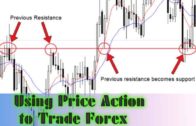If you are trading for any time at all, you will eventually come across the term “price action.” It is not an easily defined term, as there is no set parameter as to what would be price action or what would not be price action. Ultimately, price action is the movement of the markets over time. In other words, if the market is rising in a Forex pair, then it would be considered to be “positive price action”, or perhaps “bullish price action.” On the other hand, if a market is falling, then it is considered to be “negative price action”, or sometimes is called “bearish price action.”
Luckily, charting platforms make it quite simple to see whether or not the most recent action or even longer term action in the market is positive or negative, and learning to read price action is the most basic of skills that you will need as a Forex trader. For example, you need to understand whether or not price has been rising or falling over the longer term, giving you the ability to understand the most likely of outcomes for any trade that you have.
Price action encompasses everything that happens
Sometimes, price action is simply the market going back and forth. This is referred to as “consolidation”, is quite often forms various technical patterns that people will pay attention to. Bullish flags, bearish flags, rectangles, triangles, and many other formations are referred to by their name, but essentially it is just a form of the market going back and forth before its next move. In this scenario, you need to pay attention to the fact that the market is going nowhere in the short term, but also recognize when price action suddenly changes, and we break out of an area of back-and-forth trading. This shows that the market is ready to start trending again.
By being able to read what the market is doing, you have the ability to place trades with a bit more confidence, but nothing is 100% accurate. However, over the longer term if you do trade with the market and the price action, then you have much more likelihood of becoming successful.
You should never trade against price action
One of the biggest mistakes that retail traders will make is that they try to trade against price action. For example, they may believe that the currency pair has “fallen too far”, and then start buying it. That is the wrong way to look at the market, because quite frankly the market can move much further than you anticipate. There is a reason that the market has been falling, and simply jumping in because it is “cheap” is a great way to lose money, because things can always get “cheaper.” Obviously, this works the opposite way as well. If the market has “risen too far” it is not time to start trying to sell it.
Recognize when markets break support or resistance
Price action encompasses almost everything you can see on a chart. However, one of the most important things that new traders can learn is to recognize when support or resistance has been broken. If there is a level that the market has had trouble breaking above, but then finally does, that can be for referred to as “the market breaking above resistance.” On the other hand, if there is an area that the market has not been able to fall through, but eventually does, then it becomes a break down below support. These are signs that the market is highly likely to go further, and this gives you a hint that you want to be involved with that move.
Study price action
In order to become a successful technical trader, you will need to learn price action in general. This involves shapes, trends, and even to a lesser extent indicators. If you do not study and then pay attention to price action, you are doomed to fail. You need to know what the market is trying to tell you. While nothing will keep you from having losses, if you work with the market as opposed to against it, you have a much better chance of success.



 Difference Between Hammer and Hanging Man 2023 [ Must Watch for Trader ]
Difference Between Hammer and Hanging Man 2023 [ Must Watch for Trader ]